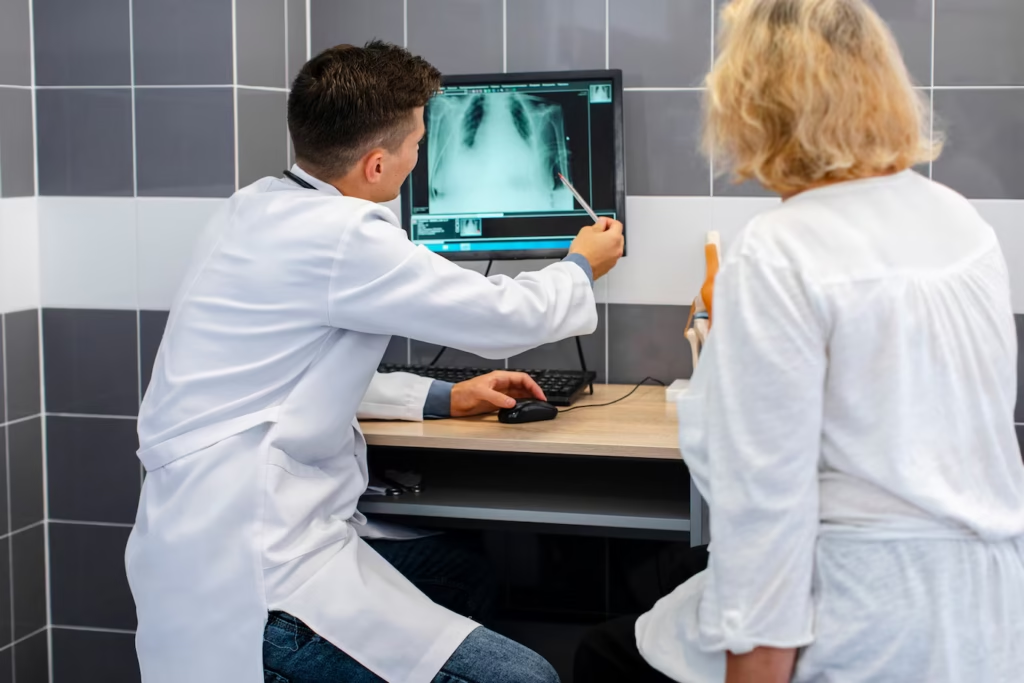Introduction to Congenital Lobar Emphysema in Radiology
This article serves as a thorough guide to congenital lobar emphysema in radiology. Congenital lobar emphysema (CLE) is a rare but significant pulmonary condition predominantly affecting infants. Characterized by an abnormal enlargement of one or more lobes of the lung, CLE can lead to respiratory distress and other complications. This article aims to provide a thorough understanding of Congenital Lobar Emphysema in Radiology from a radiological perspective, offering insights into its diagnosis, management, and implications for patient care. By the end, readers will have a clearer understanding of this condition, its radiological features, and the importance of timely intervention.

Table of Contents
What is Congenital Lobar Emphysema?
Congenital lobar emphysema is a developmental anomaly of the lungs, where one or more lobes become overinflated. This condition typically presents in infants and can be attributed to various factors, including bronchial obstruction and abnormal lung development. The most commonly affected lobe is the left upper lobe, although any lobe can be involved.
Causes of Congenital Lobar Emphysema
The exact etiology of congenital lobar emphysema remains unclear, but several potential causes have been identified, including:
- Bronchial Atresia is a congenital condition characterized by the absence or obstruction of a segment of the bronchus, which can result in the trapping of air within the lungs. This condition can significantly affect respiratory function and may lead to various complications if not identified and managed appropriately.
- Intrauterine factors play a notable role in the development of congenital lung diseases, with maternal smoking being a key risk factor. Additionally, exposure to certain infections during the pregnancy may also contribute to the likelihood of this condition occurring, further emphasizing the importance of maternal health during gestation on the future respiratory health of the infant.
- Genetic factors could also be involved in some instances of bronchial atresia, as there may be a hereditary component to its occurrence. However, it is important to note that specific genetic markers associated with this condition have not yet been definitively identified through research. This area of study remains open for further investigation to better understand the genetic underpinnings of bronchial atresia and its related conditions.
Understanding these underlying causes is crucial for healthcare providers in diagnosing and managing the condition effectively.
Features of Congenital Lobar Emphysema in Radiology
Radiology plays a pivotal role in diagnosing Congenital Lobar Emphysema in Radiology. The following imaging modalities are commonly employed:
Chest X-ray for Diagnose Congenital Lobar Emphysema in Radiology
A chest X-ray is often the first imaging study performed when CLE is suspected. Key features to look for include:
- Increased Volume in the Affected Lobe: The lobe that is impacted by the condition appears significantly larger than what is typically observed in a healthy lung due to the presence of air trapping within it. This enlargement is a direct consequence of the abnormal accumulation of air, which prevents proper ventilation and contributes to the overall distension of the lung lobe.
- Displacement of the Mediastinum: The mediastinum, which is the central compartment of the thoracic cavity, may exhibit a noticeable shift away from the side that is affected by the condition. This shift serves as an important indicator of volume loss occurring in the lung on the opposite side. As the affected lung lobe becomes distended, the healthy lung compensates by altering its position, revealing the interplay between the two lungs in cases of pathological change.
- Deformation of the Diaphragm: On the side that is impacted, the diaphragm may appear to be flattened or less domed than usual. This alteration is primarily a result of the increased volume that the affected lung lobe experiences and is indicative of the abnormal pressure dynamics that occur within the thoracic cavity. A flattened diaphragm can affect respiratory function, contributing to difficulties in breathing and ventilation efficiency.

Computed Tomography (CT) Scan
A CT scan provides a more detailed view of the lung anatomy and can help confirm the diagnosis. Radiologists look for:
- Lobar Overdistension: There is clear and definitive evidence indicating the presence of overinflation in the affected lobe of the lung. This overdistension can significantly impact respiratory function and overall pulmonary health.
- Bronchial Obstruction: A thorough identification of any obstructive lesions or malformations is crucial, as these can impede normal airflow and contribute to respiratory complications. It is essential to assess the airway for any potential blockages that may be present in the bronchial passages.
- Associated Anomalies: The use of CT scans can greatly assist in detecting any coexisting congenital abnormalities. Such associated anomalies are not uncommon in patients diagnosed with Congenital Lung Malformations (CLE) and may require additional evaluation and management strategies.
Magnetic Resonance Imaging (MRI)
While less commonly used than X-ray or CT, MRI can be beneficial in specific cases, especially in evaluating vascular structures and soft tissue anomalies.
Clinical Presentation and Diagnosis for Congenital Lobar Emphysema in Radiology
Infants with congenital lobar emphysema typically present with respiratory distress shortly after birth. Symptoms may include:
- Tachypnea refers to rapid or accelerated breathing that occurs as a result of impaired gas exchange within the lungs. This condition can be a significant indication that the body is struggling to adequately oxygenate the blood and remove carbon dioxide.
- Cyanosis is characterized by a bluish discoloration visible on the skin, particularly evident in areas such as the lips or fingertips, and serves as a warning sign that oxygen levels in the bloodstream are critically low. This manifestation should prompt immediate attention, as it may indicate serious respiratory issues.
- Grunting is another important clinical sign that often indicates a state of respiratory distress in an individual. It is frequently observed alongside other symptoms, such as retractions of the chest wall, where the skin pulls inwards during the act of breathing, suggesting that the person is working harder to obtain adequate air.

Diagnosis of Congenital Lobar Emphysema in Radiology
The diagnosis of congenital lobar emphysema is primarily based on clinical presentation and radiological findings. A thorough history and physical examination are crucial, followed by appropriate imaging studies. In some cases, bronchoscopy may be performed to assess for any obstructive lesions directly.
Management of Congenital Lobar Emphysema in Radiology
The management of Congenital Lobar Emphysema in Radiology depends on the severity of the condition and the presence of associated anomalies. Treatment options include:
Observation
In mild cases where the infant is stable, close monitoring may be sufficient. Regular follow-up and imaging studies can help ensure that the condition does not worsen.
Surgical Intervention
In more severe cases, surgical intervention may be necessary. The most common procedure is lobectomy, where the affected lobe is surgically removed. This approach can alleviate symptoms and improve respiratory function.
Supportive Care
Regardless of the treatment approach, supportive care is essential. This may include:
- Oxygen Therapy: This intervention is crucial to ensure that the infant receives adequate oxygenation, which is vital for maintaining proper cellular function and overall health.
- Nutritional Support: It is particularly important to provide nutritional support when the infant is experiencing difficulties feeding due to respiratory distress. Adequate nutrition is essential for growth and development, especially when the child is already compromised by respiratory challenges.
- Respiratory Support: In certain situations, it may become necessary to implement mechanical ventilation as a means of providing adequate respiratory support. This intervention can help to ensure that the infant can breathe effectively and receive the oxygen needed for recovery.
Prognosis and Long-Term Outcomes for Congenital Lobar Emphysema in Radiology
The prognosis for infants with congenital lobar emphysema varies based on the severity of the condition and the timing of intervention. Early diagnosis and appropriate management can lead to favorable outcomes, with many children going on to lead healthy lives. However, some may experience long-term respiratory issues, necessitating ongoing follow-up and care.
Conclusion
Congenital lobar emphysema is a complex condition that requires a multidisciplinary approach for effective management. Radiology plays a crucial role in diagnosis and treatment planning, making it imperative for healthcare providers to be well-versed in the radiological features of this condition. By understanding congenital lobar emphysema, its causes, and its implications, healthcare professionals can provide better care for affected infants, ultimately improving their quality of life.
Frequently Asked Questions (FAQ)
1. What is the primary cause of congenital lobar emphysema in radiology?
Congenital lobar emphysema is a condition that may arise due to a variety of factors, including bronchial obstruction, which refers to a blockage in the bronchial tubes, as well as bronchial atresia, where the bronchial passageways are not properly formed. Additionally, there are other developmental anomalies that can contribute to the manifestation of this condition. Despite thorough investigations and assessments in many cases, the precise underlying cause still often remains unidentified, leaving healthcare providers with uncertainties regarding the specific origins of the disorder in individual patients.
2. How is congenital lobar emphysema diagnosed?
Diagnosis usually entails a comprehensive approach that encompasses a combination of thorough clinical evaluation along with various imaging studies. These imaging studies typically include chest X-rays and CT scans, which are employed to effectively assess and determine the extent of lung involvement. By utilizing these diagnostic tools, healthcare professionals can gain a clearer understanding of the condition and how it has affected the lungs.
3. What treatment options are available for congenital lobar emphysema?
The various treatment options available can differ significantly depending on the severity of the condition being addressed. For cases that are less severe, careful observation may be sufficient, allowing healthcare providers to monitor the situation closely without immediate intervention. In instances where the severity warrants more aggressive action, surgical intervention may be recommended; this could include procedures such as lobectomy, which involves the removal of a lobe of the lung or other affected tissue. Additionally, supportive care measures, including oxygen therapy, may be employed to assist in maintaining adequate oxygen levels in the patient’s bloodstream, enhancing overall comfort and promoting better health outcomes during the treatment process.
4. What is the prognosis for infants with congenital lobar emphysema?
The prognosis of the condition is significantly influenced by both the severity of the illness and the timing with which treatment is initiated. When treatment is provided promptly and effectively, many infants can go on to live healthy and fulfilling lives, enjoying a good quality of life with the right management strategies in place. Appropriate care and intervention play a critical role in enabling these children to thrive despite their challenges.
5. Are there any long-term effects of congenital lobar emphysema?
Certain children may face persistent respiratory complications that require consistent monitoring and appropriate medical care over an extended period. This ongoing need for attention implies that healthcare professionals should keep a close eye on their condition to ensure that any changes are promptly addressed. Moreover, research indicates that initiating early intervention strategies can significantly enhance the likelihood of achieving more favorable long-term health outcomes for these children, making timely care an essential component of their overall treatment plan.
By providing this comprehensive overview of congenital lobar emphysema, we hope to enhance understanding and facilitate better management strategies for this condition in clinical practice.


